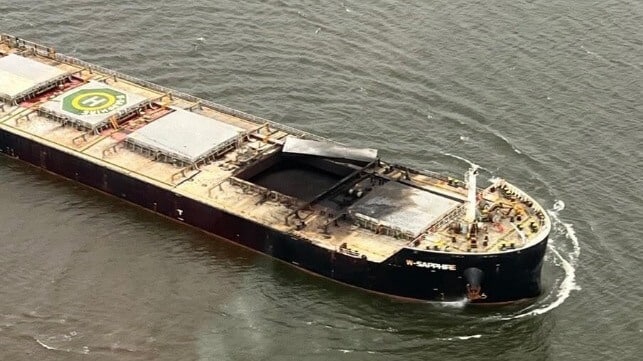USCG Lifts Hatch Cover as It Investigates Baltimore Bulker Explosion
Hatch Cover Recovered After W-Sapphire Explosion

In a significant development following the explosion on the bulk carrier W-Sapphire, authorities successfully retrieved the hatch cover that was blown overboard. The recovery took place on August 28, ten days after the incident, which occurred shortly after the vessel departed from a coal terminal in Baltimore. The Fort McHenry Federal Channel was temporarily closed to vessel traffic during the operation, ensuring safety as divers worked to recover the 30-ton hatch.
Investigation and Recovery Operations
The U.S. Coast Guard (USCG) closed the Fort McHenry Federal Channel from 7:30 AM to 3:00 PM local time on August 28, establishing a 500-yard safety zone around the hatch cover’s recovery site in the Patapsco River. Dive and salvage operations were promptly initiated, and by mid-afternoon, the hatch cover was successfully retrieved. Following the recovery, the safety zone was lifted, and the channel was reopened to traffic.
Assisting in the recovery efforts, the U.S. Army Corps of Engineers Baltimore District deployed its survey vessel, Buck, to conduct sonar surveys in the area on August 19, the day after the explosion. Captain Jake Tuer, who led the survey, stated that the data collected would inform future operational plans, including the reopening of the channel and the recovery of the hatch cover. The W-Sapphire, a 751-foot vessel, remains anchored near Sandy Point State Park as investigations continue into the cause of the explosion.
Ongoing Investigations into the Explosion
Investigators are currently examining the circumstances surrounding the explosion that resulted in the hatch cover being blown off the vessel’s number 2 hold. Witnesses reported a massive fireball that shot several hundred feet into the air, followed by a plume of smoke. Initial radio communications from the ship indicated a possible water intake issue in the hold, but the explosion’s force appeared to be primarily upward, causing the hatch cover to detach.
Authorities are exploring various potential causes for the explosion, including the possibility of spontaneous combustion or an external heat source that may have triggered the incident. Coal dust explosions often occur as secondary events, requiring a specific combination of fuel, heat, and oxygen with the dust suspended in the air. As the investigation unfolds, the focus remains on determining the exact factors that led to this alarming incident.
